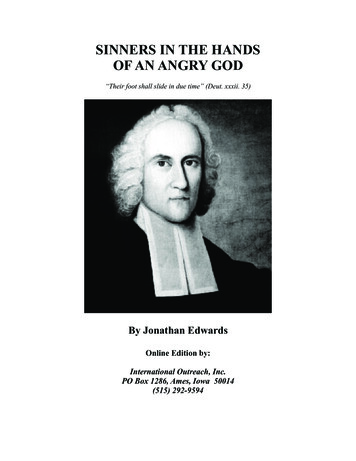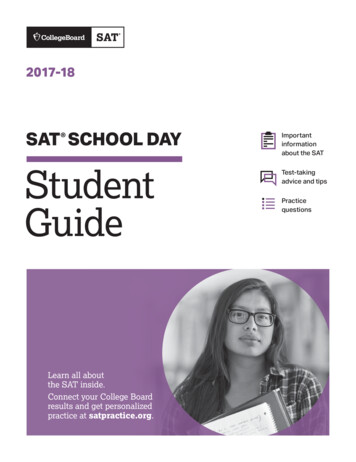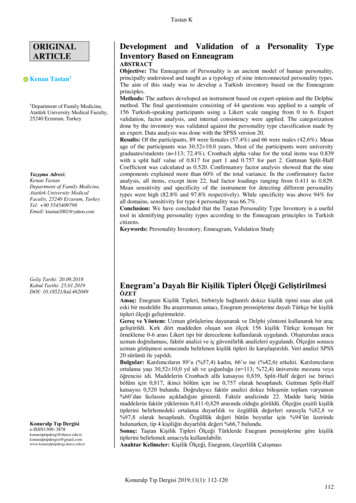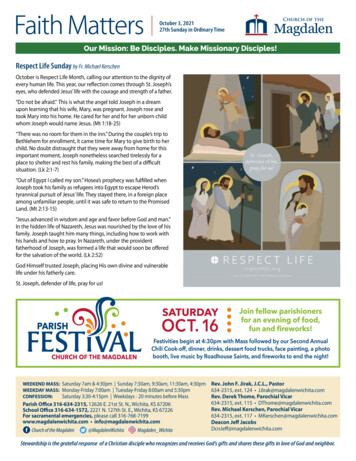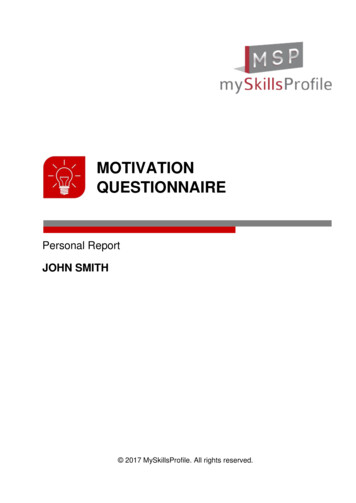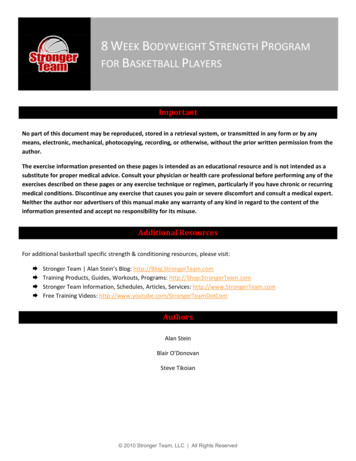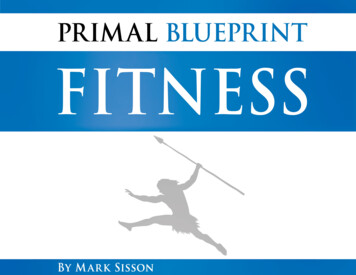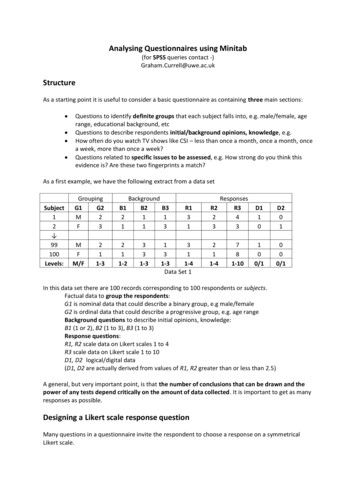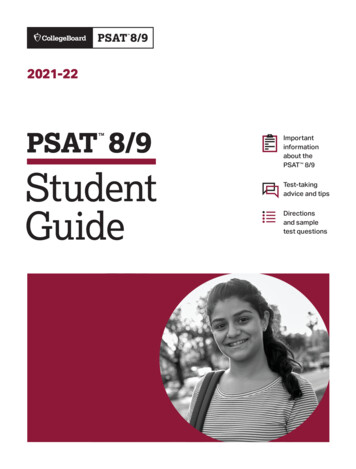
Transcription
2021-22StudentGuideImportantinformationabout thePSAT 8/9Test-takingadvice and tipsDirectionsand sampletest questions
About College BoardCollege Board is a mission-driven not-for-profit organization that connects studentsto college success and opportunity. Founded in 1900, College Board was created toexpand access to higher education. Today, the membership association is made up ofover 6,000 of the world’s leading educational institutions and is dedicated to promotingexcellence and equity in education. Each year, College Board helps more than sevenmillion students prepare for a successful transition to college through programsand services in college readiness and college success—including the SAT and theAdvanced Placement Program. The organization also serves the education communitythrough research and advocacy on behalf of students, educators, and schools. Forfurther information, visit collegeboard.org.PSAT 8/9 Customer ServiceYou can reach us Monday to Friday, 8 a.m.–9 p.m. ET(9 a.m.–7 p.m. mid-June to MAIL: 1-212-713-8105psathelp@info.collegeboard.org SAT 8/9PP.O. Box 6720Princeton, NJ 08541-6720 2021 College Board. College Board, Advanced Placement, AP, SAT, and the acorn logo are registered trademarksof College Board. PSAT, BigFuture, and Career Finder are trademarks owned by College Board. All other marks are theproperty of their respective owners.Visit College Board on the web: collegeboard.org.Khan Academy is a registered trademark in the United States and other jurisdictions.ii2021-22 PSAT 8/9Student Guide
1ContentsTest-Taking Information14Math1Using This Guide14Math Test Overview1How the PSAT 8/9 Is Organized14Calculator Use2How the PSAT 8/9 Is Scored152Create a College Board AccountAnswering Student-ProducedResponse Questions2If You Need Testing Accommodations15Tips for the Math Test2How to Prepare15Sample Math Test Materials3Test Day Items16Math Test – No Calculator Questions3What to Do If .19Math Test – Calculator Questions3Testing Guidelines22PSAT 8/9 Terms and Conditions3Privacy Policies22Introduction3Telemarketing Scams223Test Fairness ReviewSection 1. Required and ProhibitedItems for Testing4Test Question Inquiries23Section 2. Prohibited Behaviors4Makeup Testing244Useful ResourcesSection 3. Score Cancellation andDisciplinary Measures4Additional Information25Section 4. Privacy5Evidence-Based Reading and Writing25Section 5. Miscellaneous5Reading Test Overview26Section 6. Policies and Requirements6Sample Reading Test Materials26Section 7. Intellectual Property Rights7Reading Test Questions26Section 8. Arbitration of Disputes andClass Actions Waiver9Writing and Language Test Overview27Section 9. Venue and Waiver of Jury Trial10Sample Writing and Language Test Materials27Section 10. Limitations of Liability11Writing and Language Test Questions27Section 11. Severability27Section 12. Restricted Registrations27Section 13. Accessibility of TheseTerms and ConditionsStudent Guide2021-22 PSAT 8/9iii
iv2021-22 PSAT 8/9Student Guide
Using This Guide Test-Taking InformationTest-Taking InformationUsing This GuideTaking the PSAT 8/9 is a great way to find out howprepared you are for college and career. The test alsoconnects you to College Board programs and servicesthat can propel you to opportunities you’ve earned.We’ve created this guide to help you: How the PSAT 8/9Is OrganizedThe PSAT 8/9 has 3 tests: the Reading Test, the Writingand Language Test, and the Math Test. The tests breakdown like this: Become familiar with the test so you’re notsurprised or confused on test day. Learn the test directions. The directions foranswering the questions in this guide are the sameas those on the actual test. Review the sample questions. The more familiar youare with the question formats, the more comfortableyou’ll feel when you see similar questions on theactual test. In particular, be sure to practice how toanswer the student-produced response questions onthe Math Test later in this guide.Time Allotted(min.)Number ofQuestionsReading5542Writing andLanguage3040Math6038Total145120Component Be aware of what you need to know about taking thistest. You will be asked to agree to the PSAT 8/9Terms and Conditions (starting on page 22)on test day. These Terms and Conditions haveinformation on: Acceptable photo identificationRequired and prohibited items for testingAcceptable and unacceptable calculatorsTest security and fairness policiesPhone and electronic device policiesPrivacy policies, including the use of studentinformation You will be bound by the Terms and Conditions asthey exist on test day. Prior to test day, you mustreview any updates to these Terms and Conditions,which will be clearly communicated to you atcb.org/psat89-terms.Student Guide2021-22 PSAT 8/91
Test-Taking Information How the PSAT 8/9 Is ScoredHow the PSAT 8/9 Is ScoredAll multiple-choice questions are scored by giving 1 point for each correct answer. Nopoints are subtracted for incorrect answers or answers left blank. Hard questions countthe same as easier questions. You won’t lose any points for guessing, so try to answerevery question. The table shows all the scores you’ll receive on the PSAT 8/9.PSAT 8/9 Score ReportedDetailsScore RangeTotal ScoreSum of the 2 section scores240–1440Section Scores (2) Evidence-Based Reading and Writing Math120–720Test Scores (3) Reading Writing and Language Math6–36Cross-Test Scores (2) Analysis in History/Social Studies Analysis in Science6–36 Reading and Writing and Language:1–15Based on selected questions in theReading Test, Writing and LanguageTest, and Math Test. These scoresshow how well you use your skills toanalyze texts and solve problems inthese subject areas.Subscores (6)Command of Evidence and Words inContext Writing and Language: Expressionof Ideas and Standard EnglishConventions Math: Heart of Algebra, and ProblemSolving and Data AnalysisYou’ll receive a total score, section scores, test scores,cross-test scores, and subscores as well. You’ll be ableto see not only how you did overall, but also whereyour strengths are and where you need to improve.All students can visit psat.org/89scores for generalinformation about scoring.If you’re in 9th grade or higher, your score reportincludes a message about your potential for success inAP courses based on your scores.Scores will become available based on when yourschool tests. If you haven’t received your scores by lateJune, see your counselor. Your school will be able toprint a copy for you.Create a CollegeBoard AccountIf you’re age 13 or over, create a free College Boardaccount so you can access your PSAT 8/9 scores whenthey become available. Just visit collegeboard.org andclick Sign up to get started.22021-22 PSAT 8/9Student GuideIf You Need TestingAccommodationsIf you have a disability that requires accommodationssuch as braille, extra breaks, or permission to testblood sugar, be sure to work with your school, whichwill determine which accommodations are appropriate.Supports such as dictionaries, translated testdirections, and extended time are available for Englishlearners. If you need English learner (EL) support, workwith your school to ensure it will be there on test day.IMPORTANT:How to PrepareThe PSAT 8/9 measures the knowledge and skills youhave developed in reading, writing and language, andmath. Review the information in this guide, including thesample questions and directions, to become more familiarwith the test. Go to collegeboard.org/about-psat-8-9 toget more information about preparing for the test.
Test Day ItemsTest Day ItemsRefer to the Terms and Conditions on page 22 for alist of items you’ll need to bring for test day.Though not required, consider bringing: Snacks and drinks (which must be under your deskduring testing)Test-Taking InformationPrivacy PoliciesCollege Board recognizes the importance of protectingyour privacy. Please review our privacy policies atcollegeboard.org/privacy-center (“Privacy Policies”)and the PSAT 8/9 Terms and Conditions on page 22to understand our collection, use, and disclosure ofyour personally identifiable information. Extra batteries and backup calculatorWhat to Do If .You know in advance that you cannot take the teston the date your school offers it: Tell your counseloras soon as possible that you have a conflict, such asa religious observance. You may be able to take thetest at a nearby school that has selected a differenttest date. If you test at another school, be sure to takeyour school code and an acceptable photo ID withyou, keeping your ID with you at all times, especiallyif you leave the testing room. (See the PSAT 8/9 Termsand Conditions on page 22 for information aboutacceptable photo identification.)You are homeschooled and want to take thePSAT 8/9: Make arrangements in advance withyour local school or another nearby school that isadministering the test. (For a list of schools in yourarea, go to h.) If this is not possible, contact thePSAT 8/9 office (see inside front cover).You will be studying in another country when the testis given: Contact the PSAT 8/9 office and provide thename of the city and country and, if known, the name andaddress of the school you will be attending when the testis given. The PSAT 8/9 office will send you instructions.Testing GuidelinesTelemarketing ScamsWe sometimes get reports of phone scams when callersposing as employees of College Board try to sell testpreparation products or request sensitive, personallyidentifying information, such as credit card and SocialSecurity numbers. College Board does not makeunsolicited phone calls or send emails to students orfamilies requesting this type of information. This typeof activity, known as telemarketing fraud, is a crime.Test Fairness ReviewAll new PSAT 8/9 test questions and completenew editions of the tests are reviewed by external,independent educators from throughout the UnitedStates. These reviews help ensure that the questionsare unambiguous and relevant and that the languageused is not offensive to or inappropriate for anyparticular group of students based on race/ethnicityor gender. Assessment staff ensure that the test as awhole includes references to men and women as wellas to individuals from varied racial, ethnic, and culturalbackgrounds. Statistical procedures are used to identifyquestions that are harder for a group of students toanswer correctly than would be expected from theirperformance on other questions in the test; thesequestions are excluded from appearing on tests. Plan ahead and bring equipment that’s in goodworking order. Testing staff might not have extrabatteries or calculators. When marking answers: Use a No. 2 pencil with a soft eraser on allparts of the answer sheet. Do not use a pen ormechanical pencil. Make sure you fill in the entire bubble darklyand completely. Erase any changes you make as completely aspossible. Store any snacks or drinks you bring out of sightin a paper bag under your desk. You may only eatsnacks during breaks. The testing staff will tell youwhere you can go to have your snack.Student Guide2021-22 PSAT 8/93
Test-Taking Information Test Question InquiriesTest Question InquiriesAdditional InformationIn your inquiry, provide your name and mailingaddress, the date you took the PSAT 8/9, the nameand address of the school where you took the test,the test section, the test question (as well as you canremember), and an explanation of your concern aboutthe question.Additional Information on the SATIf you find what you consider to be an error or anambiguity in a test question, tell the test coordinatorimmediately after the test. You may also emailpsatquestion@collegeboard.org.The PSAT 8/9 Program will send you a writtenresponse after your inquiry has been reviewedthoroughly by subject-matter specialists.We will not respond via email, so be sure toinclude your full name and mailing address.IMPORTANT:Makeup TestingDuring bad weather, natural disasters, power outages,or other unusual conditions, test sites may be closed.The following policies apply to makeup testing: The availability of makeup testing and the conditionsthat make test takers eligible to take a makeup testare at the sole discretion of College Board. You must take the entire PSAT 8/9 at a makeup test. Access to scores from makeup administrations maybe delayed by several weeks.Additional Terms and Conditions may apply to yourmakeup test.Complete descriptions of the content of the test andinformation on test preparation and sample questionsare provided in the PSAT 8/9 Student Guide (“Guide”)and online at psat.org/8-9.A primary purpose of the SAT is to determine howprepared students are to succeed, both in college andin career training programs. Extensive research onthe predictive validity of the SAT has established itsutility and value as a College Entrance Exam throughstudies on the relationship between SAT scores andfirst-year grade point average (“FYGPA”), retention,domain-specific course grades, GPA through each yearof college, as well as completion. A 2019 national SATValidity Study t-validity-study.pdf), based on datafrom more than 223,000 students across 171 four-yearcolleges and universities, found the following: SAT scores are strongly predictive of collegeperformance—students with higher SAT scores aremore likely to have higher grades in college. SAT scores are predictive of student retention totheir second year—students with higher SAT scoresare more likely to return for their sophomore year. SAT scores and High School grade pointaverage (“HSGPA”) are both related to academicperformance in college but tend to measure slightlydifferent aspects of academic preparation. UsingSAT scores in conjunction with HSGPA is themost powerful way to predict future academicperformance. On average, SAT scores add 15% moreUseful ResourcesWe offer resources to help you find the best college andcareer for you, including:BigFuture —Our website helps you plan forcollege and find the college that’s best for you.Visit bigfuture.org.Career Finder —Want to make smart, informeddecisions about your future major and career basedon your passions and interests? Try this engagingonline experience powered by our partnership withRoadtrip Nation. Visit roadtripnation.com/edu/careerfinder.42021-22 PSAT 8/9Student Guidepredictive power above grades alone forunderstanding how students will perform incollege. SAT scores help to further differentiate studentperformance in college within narrow HSGPAranges. Colleges can use SAT scores to identify studentswho may be in need of academic support beforethey start college and throughout their collegeeducation by monitoring predicted versus actualperformance and help position these students forsuccess.
Reading Test Overview Evidence-Based Reading and WritingEvidence-Based Reading and WritingThe Evidence-Based Reading and Writing section iscomposed of 2 tests that assess different but related skillsand knowledge. The Reading Test gives you a chance toshow how well you understand what you read. The Writingand Language Test asks you to revise and edit text.Reading Test Overview Total questions: 42 passage-based reading questionswith multiple-choice responses. Time allotted: 55 minutes. Calculators may not be used or be on your desk. The questions often include references to direct you tothe relevant part(s) of the passage(s).What the Reading Test Is LikeWhen you take the Reading Test, you’ll read passagesand interpret informational graphics. Then you’ll use whatyou’ve read to answer questions. Some questions ask youto locate a piece of information or an idea stated directly.But you’ll also need to understand what the author’s wordsor a graphic’s data imply.What You’ll ReadReading Test passages range in length from about500 to 750 words and vary in complexity. The ReadingTest includes: 1 passage from a classic or contemporary work of U.S.or world literature. 1 passage or a pair of passages from either a U.S.founding document (such as an essay by JamesMadison) or a text in the Great Global Conversation(such as a speech by Nelson Mandela). 1 passage on a social science topic from a field such aseconomics, psychology, or sociology. 2 science passages (or 1 passage and 1 passagepair) that examine foundational concepts or recentdevelopments in Earth science, biology, chemistry,or physics. 2 passages accompanied by 1 or more informationalgraphics.What the Reading Test MeasuresTo succeed in college and career, you’ll need to applyreading skills in all sorts of subjects. You’ll also needthose skills to do well on the Reading Test.The Reading Test measures skills and knowledge you’llneed to apply when reading in college and workforcetraining programs. The test will ask you to find andinterpret information and ideas, analyze how texts areput together and why they’re written the way they are,work with data from informational graphics, and makeconnections between paired passages.You’ll be asked questions that require you to draw on thereading skills and knowledge needed most to succeed inthe subjects the passages are drawn from. For instance,you might read about an experiment and then seequestions that ask you to examine hypotheses, interpretdata, or consider implications.Answers are based only on the content stated in or impliedby the passages and in any supplementary material, suchas tables and graphs.Command of EvidenceSome questions ask you to: Find evidence in a passage (or pair of passages) thatbest supports the answer to a previous question orserves as the basis for a reasonable conclusion. Identify how authors use (or fail to use) evidence tosupport their claims. Locate or interpret data in an informational graphic, orunderstand a relationship between a graphic and thepassage it’s paired with.Words in ContextSome questions focus on important, widely used wordsand phrases that you’ll find in texts in many differentsubjects. The words and phrases are ones that you’ll usein college and the workplace long after test day.These questions focus on your ability to: Figure out the meaning of words or phrases in context. Decide how an author’s word choice shapes meaning,style, and tone.Analysis in History/SocialStudies and in ScienceYou’ll be asked to read and analyze passages about topicsin history/social studies and in science.Student Guide2021-22 PSAT 8/95
Evidence-Based Reading and Writing Sample Reading Test MaterialsTips for the Reading TestTo answer each question, consider what the passageor passages say directly, and use careful reasoning todraw supportable inferences and conclusions from thepassage(s). The best answer to each question is derivedfrom what is stated or implied in the passage(s) ratherthan from prior knowledge of the topics covered. All ofthe questions are passage based. Reading carefully is the key to finding the bestanswer to each question. The information you needto answer each Reading Test question is always inthe passage(s). Don’t be misled by an answer thatlooks correct but isn’t supported by the actual text ofthe passage(s). The questions don’t increase in difficulty from easyto hard. Instead, they are presented as logically aspossible. Questions about central ideas and themes,point of view, and overall text structure generallycome early in the sequence. After that come morespecific questions about such matters as facts,details, and words in context. Stay with a passage until you have answered asmany questions as you can before you proceed to thenext passage. Don’t jump from passage to passage. The questions often include references to help directyou to relevant part(s) of the passage(s). You mayhave to look elsewhere in the passage, however, tofind the best answer to the question. In your test booklet, mark each question you skip soyou can easily go back to it later if you have time. Remember that all questions are worth 1 pointregardless of the type or difficulty. You don’t losepoints for guessing wrong, so you should try toanswer each question as best you can.62021-22 PSAT 8/9Student GuideSample ReadingTest MaterialsFollowing are samples of the kinds of passages andquestions that may appear on the Reading Test. For eachset of sample materials: Read the passage(s) and any supplementary materialcarefully. Decide on the best answer to each question. Read the explanation for the best answer to eachquestion and for the answer you chose (if they aredifferent).On the actual test, each passage will be followed by8 or 9 questions. The directions that follow match thedirections on the actual test.
Reading Test Questions Evidence-Based Reading and WritingReading Test QuestionsDIRECTIONSEach passage or pair of passages below isfollowed by a number of questions. After readingeach passage or pair, choose the best answerto each question based on what is stated orimplied in the passage or passages and in anyaccompanying graphics (such as a table or graph).3540US and World LiteraturePassageHigher Text ComplexityQuestions 1-4 are based on the following passage.This passage is adapted from David Foster Wallace, “All That.” 2009 by Condé Nast.Line51015202530Once when I was a little boy I received as a gift atoy cement mixer. It was made of wood except forits wheels—axles—which, as I remember, were thinmetal rods.It was the same overlarge miniature as manyother toy vehicles—about the size of a breadbox.It weighed three or four pounds. It was a simpletoy—no batteries. It had a colored rope, with a yellowhandle, and you held the handle and walked pullingthe cement mixer behind you—rather like a wagon,although it was nowhere near the size of a wagon.I liked the cement mixer and played with it asmuch as or more than I played with the other toyvehicles I owned. At some point, several weeks ormonths after the holidays, however, my biologicalparents led me to believe that it was a magic and/or highly unusual cement mixer. Probably mymother told me this in a moment of adult boredomor whimsy, and then my father came home fromwork and joined in, also in a whimsical way. Themagic—which my mother likely reported to mefrom her vantage on our living room’s sofa, whilewatching me pull the cement mixer around the roomby its rope, idly asking me if I was aware that it hadmagical properties, no doubt making sport of mein the bored half-cruel way that adults sometimesdo with small children, playfully telling them thingsthat they pass off to themselves as “tall tales” or“childlike inventions,” unaware of the impact thosetales may have (since magic is a serious reality for smallchildren). The “magic” was that, unbeknown to me,455055606570as I happily pulled the cement mixer behind me, themixer’s main cylinder or drum—the thing that,in a real cement mixer, mixes the cement; I do notknow the actual word for it—rotated, went aroundand around on its horizontal axis, just as the drum ona real cement mixer does. It did this, my mother said,only when the mixer was being pulled by me andonly, she stressed, when I wasn’t looking. She insistedon this part, and my father later backed her up: themagic was not just that the drum of a solid woodobject without batteries rotated but that it did so onlywhen unobserved, stopping whenever observed. If,while pulling, I turned to look, my parents somberlymaintained, the drum magically ceased its rotation.How was this? I never, even for a moment, doubtedwhat they’d told me. This is why it is that adultsand even parents can, unwittingly, be cruel: theycannot imagine doubt’s complete absence. Theyhave forgotten.The point was that months were henceforwardspent by me trying to devise ways to catch the drumrotating. Evidence bore out what they had told me:turning my head obviously and unsubtly aroundalways stopped the rotation of the drum. I also triedsudden whirls. I tried having someone else pull thecement mixer. I tried incremental turns of the headwhile pulling (“incremental” meaning turning myhead at roughly the rate of a clock’s minute hand).I tried peering through a keyhole as someone elsepulled the cement mixer. Even turning my head atthe rate of the hour hand. I never doubted—it didn’toccur to me. The magic was that the mixer seemedalways to know. I tried mirrors—first pulling thecement mixer straight toward a mirror, then throughrooms that had mirrors at the periphery of my vision,then past mirrors hidden such that there was littlechance that the cement mixer could even “know” thatthere was a mirror in the room. My strategies becamevery involved. I was in kindergarten and home halfthe day. The seriousness with which I tried must havecaused my parents no little anguish of conscience.Student Guide2021-22 PSAT 8/97
Evidence-Based Reading and Writing Reading Test Questions1Choice A is incorrect because the narrator indicates that hespent “months . trying to devise ways to catch the drumrotating.”The main purpose of the second paragraph(lines 5-11) is toChoice B is incorrect because the narrator describes asunintentionally cruel his biological parents’ claim that the toycement mixer’s drum rotated and indicates that his parentsmust have experienced “no little anguish of conscience” afterseeing how earnestly he believed the claim.A) describe the toy cement mixer.B) list the narrator’s favorite toys.C) show that simple toys are as fun ascomplicated ones.D) explain why the narrator liked the toycement mixer.Content: Rhetoric/Analyzing purposeFocus: Students must determine the most likely purpose ofa particular part of a text.Key: AEstimated Difficulty: Easy3Which choice provides the best evidence for theanswer to the previous question?Choice A is the best answer because the second paragraphprimarily offers a description of the toy cement mixer. In theparagraph, the narrator describes the size, appearance, andmechanisms of the toy, noting, for example, that it was “aboutthe size of a breadbox,” had “a colored rope, with a yellowhandle,” and was pulled “rather like a wagon.”A)B)C)D)Choice B is incorrect because although the narrator refersin the second paragraph to “many other toy vehicles” andcompares the toy cement mixer to a wagon, he does not listhis toys or indicate which toys were his favorites.Content: Information and Ideas/Citing textual evidenceChoice C is incorrect because although the narratorstates in the second paragraph that the toy cementmixer was “a simple toy,” he does not compare it tocomplicated toys or indicate that simple toys andcomplicated toys are equally fun to play with.Choice D is incorrect because although the narratordescribes in the second paragraph the size, appearance,and mechanisms of the toy cement mixer, he doesnot explain why the mixer appealed to him.2The narrator’s interest in trying to see the toycement mixer’s drum rotate can best be described ontent: Information and Ideas/Reading closely/Determiningimplicit meaningsFocus: Students must draw a logical conclusion froma text.Key: DEstimated Difficulty: HardChoice D is the best answer because the narrator describeshis numerous attempts to see the toy cement mixer’sdrum rotate, the “months” he spent on this task, and the“seriousness with which [he] tried” to complete the task.8Choice C is incorrect because the narrator’s interest in seeingthe drum rotate was so compelling that he spent “months trying to devise ways to catch the drum rotating” and becausethere is no evidence in the passage that the narrator felt anyreluctance about the task he had set for himself.2021-22 PSAT 8/9Student GuideLines 31-37 (“The ‘magic’ does”)Lines 43-45 (“If rotation”)Lines 47-49 (“This absence”)Lines 51-53 (“The point rotating”)Focus: Students must cite the textual evidence that bestsupports a given point.Key: DEstimated Difficulty: MediumChoice D is the best answer because in this sentence, thenarrator states that after being told by his biological parentsthat the toy cement mixer’s drum would only rotate when hewas pulling the mixer and when he was not looking at it, hespent “months trying to devise ways to catch the drumrotating.” That the narrator devoted a long period of time tonumerous attempts to see the drum rotating suggests that hisinterest in seeing it rotate was very strong.Choice A is incorrect because this sentence reveals onlythat the narrator’s biological parents told him that thetoy cement mixer’s drum would magically rotate as thenarrator pulled the mixer. The sentence does not show thatthe narrator’s interest in seeing the drum rotate was verystrong.Choice B is incorrect because this sentence reveals onlythat the narrator’s biological parents told him that thetoy cement mixer’s drum would stop its magical rotationwhenever the narrator looked at it. The sentence does notshow that the narrator’s interest in seeing the drum rotatewas very strong.Choice C is incorrect because this sentence focuses on thenarrator’s claim that parents can be unintentionally cruelwhen they fail to realize that children will unquestioninglybelieve what they say. Although the sentence suggests thatthe narrator did not doubt his biological parents’ claim thatthe toy cement mixer was magical, it does not convey thestrength of his interest in seeing the drum rotate.
Writing and Language Test Overview Evidence-Based Reading and Writing4As used in line 52, “catch” most nearly meansA)B)C)D)overtake.receive.witness.meet with.Writing and LanguageTest OverviewThe Writing and Language Test asks you to be an editorand improve passages that were written especially forthe test—and that include deliberate errors. Total questions: 40 passage-based questions withContent: Information and Ideas/Interpreting words andphrases in contextFocus: Students must determine the meaning of a word incontext.Key: CEstimated Difficulty: MediumChoice C is
2021-22 deut n t S e id Gu Important information about the PSAT 8/9 Test-taking advice
